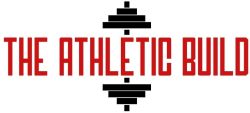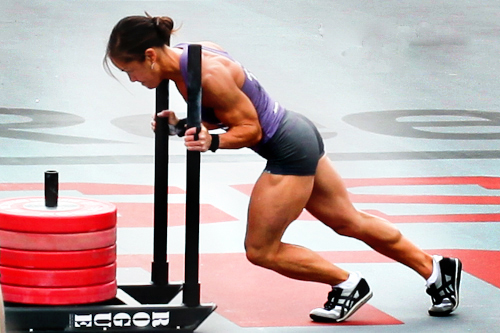The cable machine offers an incredibly diverse range of benefits to every lifter. Not only can they optimize hypertrophy training, but cables give you more joint stability than free weights or other machines–making them great for getting a pump without causing too much stress on your joints.
The cable system also offers a consistent challenge that allows for a more accurate and efficient training stimulus than many other devices in the gym.
In this article, we’ll break down the best cable exercises for muscle building and strength and give you tips on how to execute each movement correctly.
Seated Cable Row
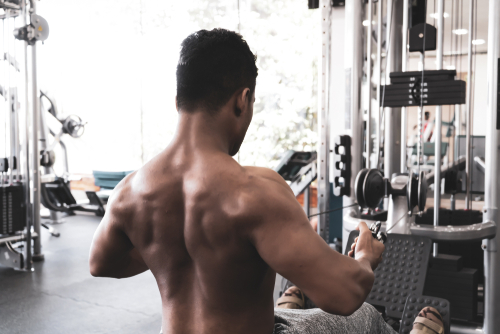
The seated cable row is a great cable exercise that is very popular. At my gym, the machine is almost in constant use. The movement primarily works the latissimus dorsi, traps, and rhomboids. It also even works the biceps, traps, and rear delts.
How to do a Seated Cable Row
- Sit with your legs straight and your back straight. Grab the handle with an overhand grip, ensuring your hands are shoulder-width apart.
- Keep your core engaged and lean back slightly, keeping a slight bend in your knees. This is your starting position.
- From here, row the handle back towards your chest, squeezing your shoulder blades together as you do so.
- Pause for a moment at the top of the contraction, and then slowly return to the starting position.
You can use many different handles for the seated cable row with various widths and hand positioning. The best one is the one that you feel works the best for you; give them all a try and pick what you like best.
Lat Pulldowns

Looking for a wide back? Lat pulldowns can help!
Lat pulldowns are another great cable exercise that works the lats, biceps, traps, and rear delts.
You can do the lat pulldown in various ways, such as wide or narrow grip and the behind-the-neck variation.
I personally prefer the wide grip lat pulldown as it works my lats better than the other variations.
The lat pulldown is also a great way to work and strengthen the lats for people who can’t do pull-ups.
How to do a Wide Grip Lat Pulldown
- Sit down on a lat pulldown machine and grab the bar with an overhand, outside shoulder-width grip.
- Exhale and bring the bar down to your chest.
- Squeeze your back muscles and hold for a second.
- Slowly return to the starting position as you inhale.
Triceps Pushdowns
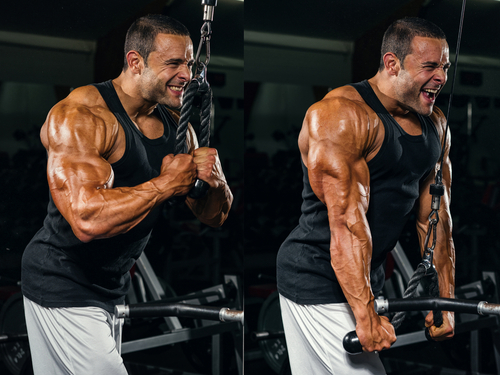
Want a horseshoe triceps? Pushdowns can help you get them.
This cable exercise primarily works the triceps, but all three heads of the muscle group are worked to some extent.
The triceps pushdown can be done with a rope, straight bar, or V-bar attachment. I personally like using the rope as it feels better on my joints, and I feel it hits my triceps more.
How to do Triceps Pushdowns
- Start with the cable stack placed in the highest position and select the desired grip attachment.
- Standing upright with the chest up and the shoulders back, take hold of the cable attachment and bring your elbows close to your sides.
- Keeping your upper arms stationary, exhale as you extend your forearms and flex your triceps until your arms are fully extended.
- Slowly return to the starting position as you inhale by allowing the triceps to relax and the cable attachment to raise back to the starting position.
Face Pulls
Face pulls are a great way to build up your traps, rhomboids, and rear delts.
This cable exercise is often overlooked, but it’s a great movement to include in your workouts.
This exercise helps put the shoulders through the natural glenohumeral rhythm that it needs to hit the traps, rhomboids, and external rotators of the shoulder. Making this exercise a shoulder saver, posture builder, and upper-back muscle builder all in one.
How to do Face Pulls
- Attach a rope handle to the cable stack and set it at about shoulder height.
- Grab the rope with your palms facing each other and step back until there is tension on the cable.
- Keeping your elbows slightly bent and pointed outward, pull the rope towards your face while contracting your traps and rear delts.
- Pause for a moment at the top of the contraction and then slowly return to the starting position.
Related: 11 Best Cable Machines on the Market
Cable Curls
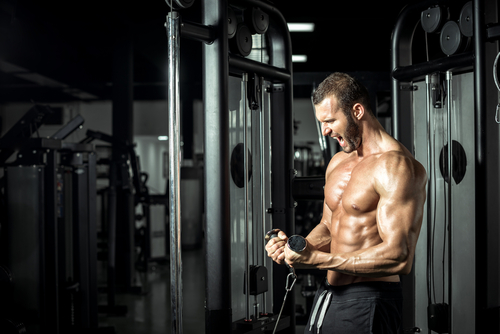
Biceps lovers can rejoice. We have reached the cable curl!
This cable exercise primarily works the biceps, but the brachialis and brachioradialis are also worked to some extent.
The cable curl can be done with a rope attachment, straight bar, or EZ-bar attachment. I personally like using the rope which allows me to use a neutral grip.
How to do Cable Curls
- Start by attaching a rope handle to the cable stack and selecting the desired weight.
- Standing up with your chest up and shoulders back, take hold of the rope with your palms facing each other.
- Keeping your upper arms stationary at your sides, exhale as you curl the rope until your forearms are fully contracted.
- Squeeze your biceps for a second and then slowly return to the starting position as you inhale by allowing the cable to straighten your arms.
Cable Crossover
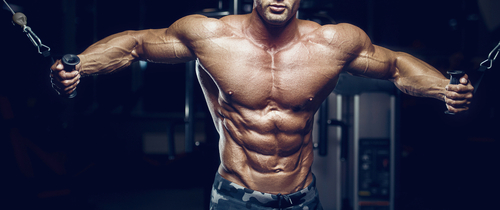
Guys love this exercise. It makes them feel like their chest is super ripped, and they should be doing it shirtless in a magazine photoshoot or something along those lines. Don’t ask me why, guys are weird.
The cable crossover is a great cable exercise for building the chest muscles.
This exercise also works the front delts, biceps, and lats to a lesser extent.
How to do Cable Crossovers
- Start by attaching two single handles to the cable stack and selecting the desired weight.
- Stand in the middle of the cable machines with your feet shoulder-width apart and your palms facing each other.
- Keeping your core tight, exhale as you bring the handles together in front of your chest while contracting your pecs.
- Pause for a moment at the top of the contraction, then slowly return to the starting position as you inhale.
Cable Pull Through
Looking for cable exercises to work those buns? The cable pull-through is just what the doctor ordered.
This exercise primarily works the glutes and hamstrings, but the lower back, quads, and core muscles are also worked.
How to do Cable Pull Throughs
- Start by attaching the rope attachment to the cable stack and selecting the desired weight.
- Facing away from the cable machine, take hold of the rope with your palms facing each other and step forward until there is tension on the cable.
- Keeping your core tight, exhale as you pull the rope through your legs while contracting your glutes and hamstrings.
- Squeeze your glutes hard at the top of the contraction and then slowly return to the starting position as you inhale by allowing the cable to pull your arms forward.
Overhead Triceps Extension
Up next, we have one of the best cable machine exercises for the triceps.
The overhead triceps extension is an excellent exercise for hitting all 3 heads of the triceps.
If you are new to this exercise, it can be a little tricky to get into the right position do it.
Here’s how it’s done.
How to do Overhead Triceps Extensions
- Start by attaching a rope handle to the cable stack and selecting the desired weight.
- Grab the rope with your palms facing each other and step back until there is tension on the cable.
- Keeping your core tight, bend forward at the waist and bring the rope behind your head.
- Exhale as you extend your arms overhead while contracting your triceps.
- Pause for a moment at the top of the contraction, then slowly return to the starting position as you inhale by allowing the cable to return to its original position.
Cable Lateral Raise
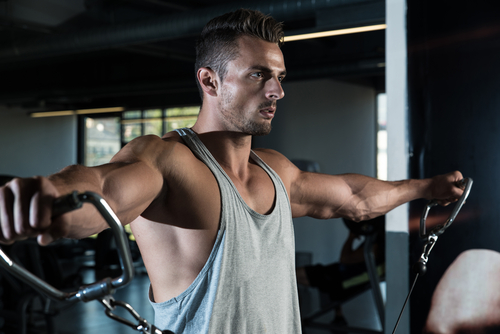
Next up on our list of the best cable exercises, we have the lateral raise.
The lateral raise is a great cable exercise for the shoulders.
It primarily works the middle delts, but the front and rear delts are also worked to some extent.
Of course, you can do them bent over so that you hit the deltoid’s rear head, which most people neglect.
The cable version of this exercise has a different feel than the dumbbell version. With the cable, there is more of an even resistance throughout which some feel is superior to doing the exercise with dumbbells.
Note: This exercise can be done with both arms or one arm at a time.
How to do Lateral Raises
- Start by attaching a D-handle to the low pulley of the cable machine and selecting the desired weight.
- Standing with your feet shoulder-width apart and your palms facing your thighs, take hold of the handle with your right hand.
- Keeping your core tight, exhale as you raise the handle out to your side until your arm is parallel to the floor while contracting your middle delt.
- Pause at the top of the contraction for a moment, then slowly return to the starting position as you inhale. Repeat the movement with your left arm.
Cable Kickback
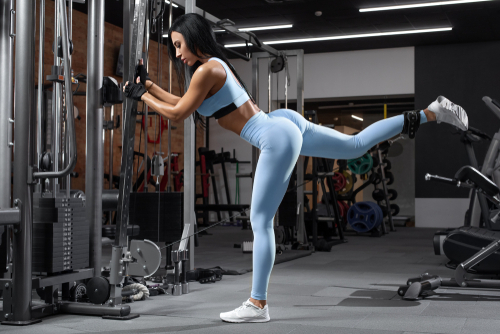
Here comes another excellent cable exercise for the glutes and hamstrings, the cable kickback.
The cable kickback is one of the best exercises to target your glutes. It allows you complete control over where they’re being worked, which makes it more effective than other versions that have set paths for everyone performing them – like machines do.
A properly executed move also reinforces good positional cues during each contraction that will help stimulate these muscles most effectively- so this works wonders even if someone doesn’t know how else would want their legs stimulated at any given time or position.
How to do Cable Kickbacks
- Start by attaching an ankle cuff to the low pulley of the cable machine and selecting the desired weight.
- After looping the cuff around your right ankle, take a few steps back from the machine until there is tension on the cable.
- Keeping your core tight and your knee bent, exhale as you raise your leg backward while contracting your glute.
- Pause at the top of the contraction for a moment, then slowly return to the starting position as you inhale by allowing the cable to pull your leg forward. Repeat the movement with your left leg.
Cable Crunch
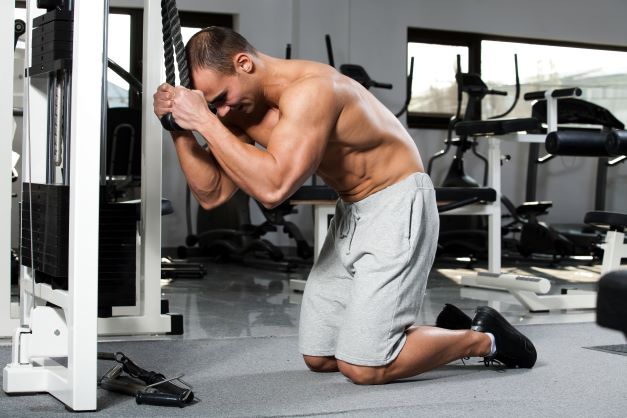
If you are looking for a good ab exercise to do on a cable machine, the cable crunch would be a good option.
This exercise allows you to perform the crunch with weight resistance, which is impossible with bodyweight movements like the regular crunch. This allows you to get your crunches done in much less time than doing sets of 30 crunches.
How to do Cable Crunches
- Start by attaching a rope attachment to the high pulley of the cable machine and selecting the desired weight.
- After grabbing the rope with your palms facing each other, lie on your back on a mat with your knees bent and your feet flat on the floor.
- With your head and shoulders off the mat, exhale as you curl your body up towards your knees while contracting your abs.
- Pause for a moment at the top of the contraction, then slowly return to the starting position as you inhale by allowing the cable to pull your body back down to the mat.
Reverse Crunch on Cable Machine
The reverse crunch is a great cable exercise for targeting the lower abs.
It is similar to the regular cable crunch, but with the reverse crunch, you are pulling your legs up towards your chest rather than your upper body towards your knees.
This makes it an excellent exercise for targeting those hard-to-train lower abdominal area.
How to do Reverse Crunches
- Start by attaching a rope attachment to the high pulley of the cable machine and selecting the desired weight.
- After grabbing the rope with your palms facing each other, lie down on your back on a mat with your knees bent and feet flat on the floor.
- With your head and shoulders off the mat, exhale as you curl your legs up towards your chest while contracting your abs.
- Pause for a moment at the top of the contraction, then slowly return to the starting position as you inhale by allowing the cable to pull your legs back down to the mat.
Cable Woodchopper
The cable woodchopper is a great exercise for working the obliques.
It is also a good exercise for working the shoulders, chest, and upper back.
This movement mimics the motion of chopping wood, thus the name. If you are a lumberjack, will this exercise make you better at your job? Quite possibly.
How to do Cable Woodchoppers
- Start by attaching a rope attachment to the lower pulley of the cable machine and selecting the desired weight.
- After grabbing the rope with both hands, stand with your feet shoulder-width apart, and your knees slightly bent.
- Bend forward at the hips and bring the rope down to the outside of your right knee.
- Keeping your core tight, exhale as you explosively twist your torso to the left and raise the rope up above your head to the left side.
- Slowly return to the starting position as you inhale. Repeat the movement on the other side.
Straight Arm Pulldown
The straight arm pulldown is a wonderful warm-up exercise for the lats that promotes mobility. This exercise can also become a back day staple as it’s a great cable exercise for building lat size.
How to do Straight Arm Pulldowns
- Start by attaching a rope attachment to the high pulley of the cable machine and selecting the desired weight.
- After grabbing the rope with your palms facing each other, stand tall with your feet shoulder-width apart and a slight bend in your knees.
- Keeping your core tight and body straight, exhale as you pull the rope down towards your thighs while contracting your lats.
- Pause for a moment at the bottom of the contraction, then slowly return to the starting position as you inhale by allowing the cable to pull the rope back up to the starting position.
Cable Shrug
We can’t forget about those traps! The cable shrug is a great exercise for targeting the traps. This is a must-do exercise if you are looking to add some size to your upper body.
How to do Cable Shrugs
- Start by attaching a dumbbell or bar attachment to the low pulley of the cable machine and selecting the desired weight.
- After grabbing the attachment with your palms facing your thighs, stand tall with your feet shoulder-width apart and a slight bend in your knees.
- Keeping your core tight and arms straight, exhale as you shrug your shoulders up towards your ears while contracting your traps.
- Then slowly return to the starting position as you inhale and repeat the movement.
Lying Biceps Curls
Here is an exercise that will both work your biceps and get people staring at you while you do it.
Novice lifters will think you are an idiot; who cares, this exercise is a solid biceps builder!
How to do Lying Biceps Curls
- Start by attaching a straight bar attachment to the low pulley of the cable machine and selecting the desired weight.
- After lying on a bench with your feet flat on the ground, grab the bar with your palms facing up and shoulder-width apart.
- Keeping your upper arms stationary, exhale as you curl the bar up towards your chest while contracting your biceps.
- Pause for a moment at the top of the contraction and squeeze the heck out of your biceps, then slowly return to the starting position as you inhale.
Cable Pallof Press
The Pallof Press is one of the best exercises for your core, and it is usually done with bands, bit it can also be done with a cable.
The great thing about this exercise is that it works not only on your abs but also the muscles around your hips and lower back.
How to do Cable Pallof Press
- Start by attaching a single handle attachment to the cable machine at about chest height and selecting the desired weight.
- After grabbing the handle with your right hand, stand perpendicular to the machine and take a few steps away from it until there is tension on the cable.
- Keeping your core tight, exhale as you press the handle straight out in front of you while contracting your abs.
- Pause for a moment at the peak of the contraction, then slowly return to the starting position as you inhale. Repeat for the desired number of reps.
The Benefits of Training With Cables
Cables offer a unique form of resistance that can be beneficial for a number of reasons:
- They provide constant tension throughout the range of motion, which can help to build muscle and strength.
- They allow you to train with various angles and planes of motion, which can help target specific muscle groups.
- Cable exercises are typically very safe and easy to perform, which makes them ideal for beginners or those new to strength training.
The good thing about cable training is that it allows for individualization, which makes the exercises more effective and diverse. It also keeps resistance consistent throughout an exercise; this means there’s always a challenge to your muscles as they grow stronger with time under tension.
How To Train with Cables
Cable training is a versatile tool that can be used to improve muscle mass and stability. These machines provide an abundance of movement options, so you’ll have no problem finding the perfect setup for your specific needs.
Not only does this type work well alone or in combination with other exercises; it’s even great as supplemental material when barbells aren’t available due its accessibility from virtually every angle around gym equipment storage areas – especially Utility weight stacks where users typically store them.
Warm-Up
Using a quick warm-up set or two is essential to maintain optimal performance and injury risk during cable exercises. Without adequately warming up, you can have an inefficient workout at best, with potential consequences including increased soreness the next day; overdoing it could lead to more severe problems such as torn muscles requiring surgery. So take 30 seconds for yourself before getting started on that new routine – just make sure not to include any other activities like jogging because this is specifically designed primarily towards strength training (and Don’t forget about form!).
Muscle Growth
Hypertrophy training parameters are often necessary when performing cable exercises. This means that you should do six to 12 reps with a weight that makes your muscles uncomfortable and approaches failure in order for the most growth potential out there.
You must be careful when using cable stacks because they can strain your joints unnecessarily. Instead of loading the weight solely onto one side, try switching up who pulls first, so no single muscle group gets too much work.
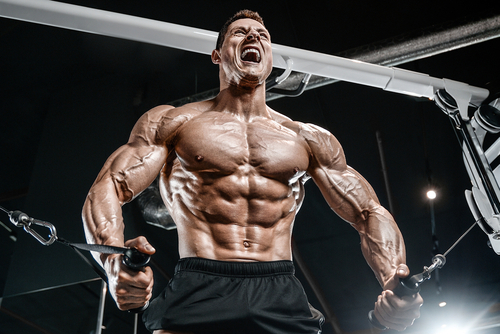
Can you build muscle with cable machines?
Cable machines are a great way to build muscle. They offer a constant tension throughout the range of motion, which can help to build muscle and strength. They also allow you to train with various angles and planes of motion, which can help target specific muscle groups. Cable exercises are typically very safe and easy to perform, which makes them ideal for beginners or those new to strength training.
If you are looking to build muscle, it is important to use a challenging weight and perform six to 12 reps with that weight. It is also important to focus on form, and to warm up before performing any cable exercises.
Are cables as good as free weights?
Cables and free weights offer different benefits. Cables provide constant tension throughout the range of motion, which can help to build muscle and strength. They also allow you to train with various angles and planes of motion, which can help target specific muscle groups. Cable exercises are typically very safe and easy to perform, which makes them ideal for beginners or those new to strength training.
Free weights offer a more natural range of motion and can help to build functional strength. They also allow you to use your body weight as resistance, which can be beneficial for some exercises. Free weights are typically best for experienced lifters looking to build strength and muscle mass.
Final Word
All in all, cable machines are a great way to add resistance training to your workout routine and can help you achieve the results you’re looking for. When using a cable machine, be sure to focus on proper form and technique so that you don’t injure yourself. Start with light weight and work your way up as you get stronger. And finally, always consult with a doctor before starting any new exercise program. Have you tried using a cable machine in your workouts? What has been your experience?

Ryan is a former college wrestler and lifelong fitness fanatic with over 25 years in the industry. He’s run half marathons, tackled mud runs, placed in body transformation contests, and coached everything from wrestling to girls’ soccer.
Along the way, he’s tested hundreds of supplements and built a deep well of supplement knowledge. His work has appeared in Muscle & Strength, Testosterone Junkie, The Sport Review, and more. Today, he’s the editor-in-chief of this site, still training hard and helping others reach their goals. Connect with him on LinkedIn below.
